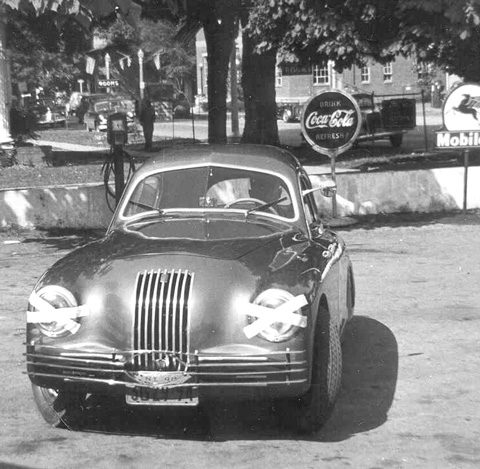
Part II brings us to mid-century, when Fiat was offering very sporting small displacement cars such as this rare 1100 S driven here by Tony Pompeo at Waktins Glen. Photo by Frank Shaffer.
By Karl Ludvigsen
The Saga of David Bruce-Brown
David Bruce-Brown, an 18-year-old prep-school lad whose mother was listed in New York’s social register, came on the scene in time for the American Grand Prize races. Driving Fiats for most of his brief but meteoric career, Bruce-Brown broke Willie Vanderbilt’s mile record at Daytona Beach in 1908.
In 1909, he beat DePalma for the Dewar Trophy. Bruce-Brown won the 1910 American G.P. for Benz but returned to Fiat in 1911 to earn third place in the inaugural Indianapolis 500, where the Fiats of Eddie Hearne and Caleb Bragg finished 21st and 37th. The 1911 American Grand Prize, where his type S74 Fiat averaged 74.4 mph for 412 miles to finish two minutes in front of Hearne’s Benz, was still another victory for David Bruce-Brown. The Fiats of Bragg and Wagner placed fourth and ninth.
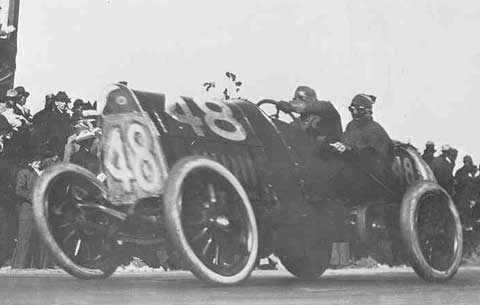
David Bruce-Brown in the winning S.74 Fiat at Savannah on a cold November 30, 1911. The S.74 was a 14.137 liter four cylinder which produced about 190hp at only 1600 rpm. Photo from “The Great Savannah Races.”
Joining Ralph DePalma and Louis Wagner at Dieppe for the 1912 running of the French Grand Prix, the young New Yorker made his European debut by taking an early lead and setting the fastest lap. Fiat S74s were running 1-2 after four laps around the 48-mile circuit. The end of the first day’s racing saw Bruce-Brown 1st, Wagner 3rd and DePalma 8th. Fewer than half of the 47 starters were able to begin the second day of the 956-mile jaunt, the rough surface having taken a fierce toll.
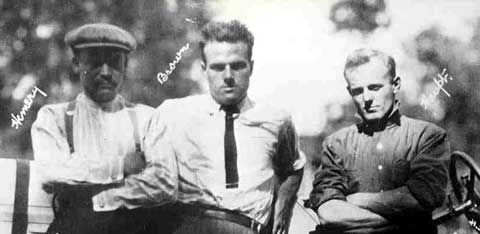
In 1910, Bruce-Brown won the American Grand Prize for Mercedes Benz. Here, Victor Hemery, left, then Bruce-Brown, and on the right Willie Haupt were the German team drivers. Photo from “The Great Savannah Races.”
The second day of racing at Dieppe saw David Bruce-Brown disqualified. Unwittingly, he had taken on fuel after stopping to repair a broken gas line. DePalma suffered a similar fate and retired. Bruce-Brown, however, pushed on to finish an unofficial third with team-mate Wagner’s Fiat coming in second to George Boillot’s Peugeot. David Bruce-Brown was never to see Europe again. A tire burst while he was practicing for the 1912 American G.P. and his car overturned. Both the driver and riding mechanic suffered fatal injuries.
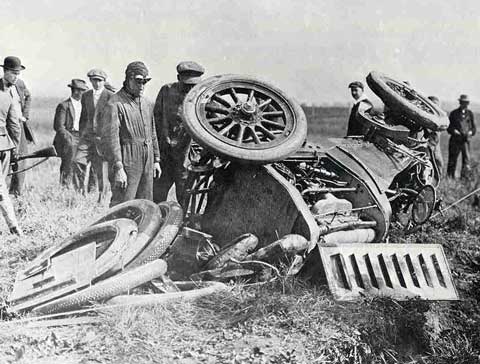
Bruce-Brown’s mother came to Savannah to urge him to quit racing, but as his racing successes continued, she became very excited about the sport. The danger caught up with young David at Milwaukee in July of 1912. The big red Fiat that killed him was the same car that gave him his 1911 victory at Savannah. Photo from “The Great Savannah Races.”
Fiat, Barney Oldfield and Ralph DePalma
Following three years in Savannah the fourth Grand Prize was staged in Milwaukee on October 5, 1912. Fiat SG1s were in the hands of two outstanding American professionals – Barney Oldfield, a superb showman as well as a great driver, and Terrible Teddy Tetzlaff, who usually broke or won. A third SG1 was driven by a wealthy sportsman, Caleb Bragg, a Fiat regular.
Although Bragg won, beating Grover Cleveland Bergdoll’s Benz by 15 minutes, the show belonged to Tetzlaff. He led almost every lap and, before breaking down well past the halfway mark, set the 77.3 mph fastest lap. Oldfield, who wasn’t all that comfortable on road courses, finished a solid 4th. For Tetzlaff, the Grand Prize was an agonizing replay of the Vanderbilt Cup race held on the same track three days earlier. Driving a smaller 589 cu. in. Cup Fiat, Teddy had led every lap until he retired at the three-quarter mark, and he again had run the fastest lap.
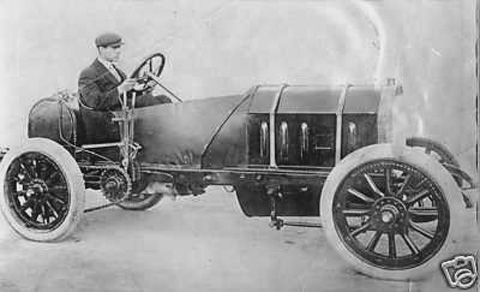
Ralph DePalma was a very active Fiat driver. De Palma is photographed aboard the Fiat Cyclone at the 1909 in New Orleans, courtesy Vintage Motorphoto. The Cyclone was a one-off reportedly built by Fiat driver Emmanuele Cedrino, who raced it in the U.S. with great success in 1908 and 1909.
Seven American Grand Prize events were held between 1908 and 1916. Crossing the nation from Savannah to Santa Monica, they were fiercely contested by the best of European and American cars and drivers. Only one make, Fiat, won three of them.
America was running round-the-clock grinds long before the good burghers of Le Mans dreamed of les 24 Heures. September 1907 saw Fiat drivers Ed Parker and Emanuele Cedrino win one of the toughest: 24 hours on the dirt at the 1.39- mile Morris Park track in the Bronx. American professionals were turning to Fiat in ever-increasing numbers. In 1909 and 1910 DePalma racked-up wins for the pride of Turin at such different tracks as Philadelphia’s Pt. Breeze oval; the 23-mile road course around Riverhead, Long Island and the Playa del Rey mile in Los Angeles.
Walter Christie’s brilliant nephew, Lewis Strang, turned a 95 mph lap for a Fiat win at the Atlanta motordrome. A month later, in December of 1909, he set a 90.8 mph 5-mile record at the Indianapolis Speedway. Eddie Hearne then copped the Cincinnati 200-mile road race for Fiat with a 58 mph average.
Racing was moving westward: Frank Verbeck and Vic Hirsh covered 1491 miles in their Fiat to win the Playa del Rey 24 hours. At Santa Monica, Teddy Tetzlaff piloted his SG1 Fiat to victory in the 303-mile “Unlimited” road race with a 78.72 mph average. Two months later a not-so-terrible Teddy helped to open Tacoma, Washington’s new 3.5-mile Montamara road course by winning the 200-mile “Heavy Car Race,” and he then beat two of the day’s best, Ed Pullen’s Mercer and Earl Cooper’s Stutz, to win a 250-mile “Free-For-All.” Some driver—some car!
Frank Verbeck and George Hill won a couple of car-breakers for Fiat in California in 1913, Verbeck taking the 444-mile Panama-Pacific, Los Angeles to Sacramento road race, while Hill beat the field around San Diego’s “short course,” two laps of 92 miles each!
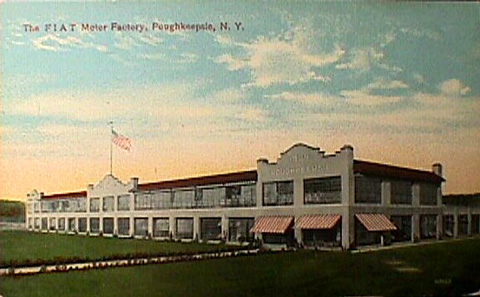
Fiat’s racing successes complemented the opening of the Poughkeepsie factory in 1908, and helped establish Fiat as a leading import until the early 1920s. A young Franklin Roosevelt Jr., who lived nearby, watched as the big Fiat 55s were serviced in Poughkeepsie. Roosevelt would later become the largest Fiat distributor in the U.S., and head the Fiat-Abarth Roosevelt Racing Team.
A new era begins
A year later Europe would be at war and a great era of racing came to a close. Almost ten years were to pass before Pietro Bordino, an accomplished Fiat works driver (Sir Henry Segrave said he was the best road racer of his time), brought a new 3-liter type 801-402 to America. January of 1922 saw Bordino’s 115.9 mph take fastest-lap honors on the boards at Beverly Hills, and that June he won a 50-mile race at the 14-mile Northway bowl in Santa Rosa.
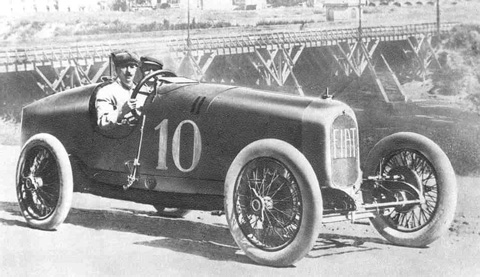
By the early 1920s the era of the Monster Fiats was long over. The 801/402 was a straight-eight three-liter with DOHCs. Pietro Bordino won at Santa Rosa in 1922 in a car similar to this. Photo Fiat.
Three years later Bordino returned to America with an 8-cylinder 1.5-liter supercharged Fiat Grand Prix car. He finished sixth in it at Culver City in March, 1925, and was back in April to win a 25-mile sprint with a 133 mph race average. Bordino then entered the former G.P. car in the 1925 Indianapolis 500, qualifying at 107.661 mph, which earned him eighth place on the grid behind a solid wall of supercharged Duesenbergs and Millers. Suffering a hand injury during a pit stop, Bordino was relieved by Antoine Mourne who helped guide the Fiat to a tenth-place finish.
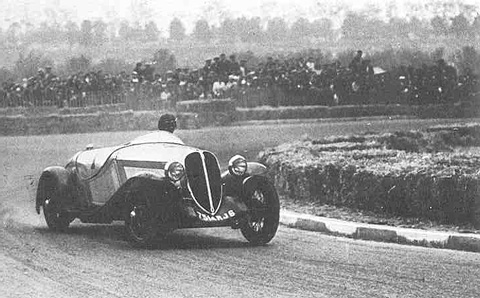
The Sorcerer, Amedee Gordini, drives a modified Simca 508S (Ballila) to victory in the Circuit d’ Orleans in 1935. Gordini would continue to modify Fiat based Simcas with great success. Photo Fiat.
During the late 1920s, Fiat became the dream machine for European specials builders and hot-rodders. Tuned 500-series Fiat sedans earned the first two places in the 1928 Monte Carlo rally. Mille Miglia class wins began falling regularly to Fiat entries.
Specializing in Fiat conversions, Siata made its debut in 1926, although it was not until after World War II that the marque took hold in American road racing. Following Siata by 10 years, Amedee Gordini (who, like Bugatti, was an Italian living in France) introduced the first of his Fiat-based Simca racers in 1939.
Another world war would intervene, but despite heavy damage, the death of the founder and total defeat, Fiat would quickly regain it’s place–and then some–in America.
Molto bene! Great to read an article about FIAT, especially the race cars. I love FIATs and have owned 11 in the last 30 years. I currently have a ’71 124 Spider and a ’76 Lancia Scorpion.
Thanks again Karl. Lots of great detail packed here. Most Americans have never heard of these great Fiat achievements. I have never seen a technical analysis of the 801/402 DOHC cars, or the 1.5-liter (91-inch on the U.S. boards) that followed for the new formula. Miller and the Duesenberg brothers have taken all the glory—and filled all the memories. And Bruce-Brown…
Nice article. One of the best resources for an “in depth” history of Fiat racing can be found in the book “Automobili Fiat” by Angelo Tito Anselmi with 150 of the 526 total pages dedicated to Fiat racing. Unfortunately, the book was only ever published in Italian but I have never found any other publication that includes such detailed information on Fiat’s racing history.
Leif………..Can I have a hi res of that Gordini fiat pic?
Roy
Re: Tire Tracks in America PII
I am looking for engine photos of P. Bordino’s 1925 Indy 500 car. The 1.5L supercharged ex-GP car.
Can you refer me to either a book or a photo source? (NB: IMS does not have any engine photos.)
Great information here! I was researching my great uncle Ralph DePalma and found this page. There are photos of him that I’d never seen. Thank you so much for the detailed history.
abarth works museum
I am now the owner from the ex USA 131 Abarth Brava car and looking about photos and info